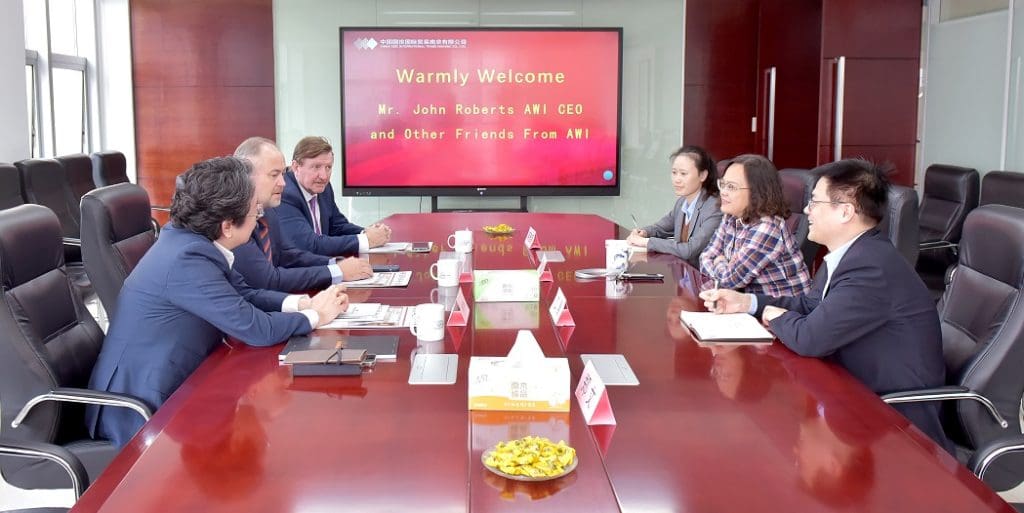
AWI CEO John Roberts, centre left, flanked by AWI country manager Jeff Ma and trade consultant Scott Carmody met with NWM manager Ms Jiang Yali, genberal manager of the Nanjing Wool Market, Mr Jiang Chen, and Madam Yang, chairwoman of SDIC Trade and Nanjing Wool Market during the recent China trip.
CHINA’S biggest wool top makers are expanding their processing capabilities with an expectation more Australian wool will be processed to be sold in China.
That is the message from Australian Wool Innovation’s chief executive officer John Roberts after meeting senior China industry figures in Shanghai, Zhangjiagang, Tongxiang, Nanjing and Beijing.
However, Mr Roberts was non-commital on any reaction in China to the Australian industry investigations into expanding early stage wool processing or on whether the Chinese processing expansion would help domestic processing viability here.
Mr Roberts met industry groups, including the China Wool Textile Association, the Nanjing Wool Market and senior executives of key wool processing operations that process Australian wool. He said it was important to go to China for the first time in almost four years.
“I went there as soon as I possibly could, because right throughout COVID and despite the hideous lockdowns they were still were able to support Australian wool growers and the domestic trade more broadly throughout that whole period, and it was important to get up there and acknowledge that and thank the Chinese processing sector on behalf of our stakeholders.
“And it’s a message that was very much appreciated,” he said.
The first part of the trip involved going to the two major processing hubs in the Yangtze Delta being Zhangjiagang and Tongxiang near Shanghai, where most of the Australian wool clip is first processed.
AWI said the meetings held with processors accounted for more than 70 percent of that buying power, the biggest top makers in China and therefore in the world.
“All of whom are reporting expansion of their processing facilities, which is really encouraging.
“That optimism is also reflected in many of the second-tier processors who are also looking to expand or have already done so during COVID,” Mr Roberts said.
“There was an underlying confidence in China and a quiet determination to expand in China.
“There is a belief that more and more Chinese consumers are going to want to wear wool,” he said.
“So, the 50pc (of wool from Australia) that now stays in China, they think is going to increase each year on year.
“And in fact, that view is also coming from the China Wool Textile Association.”
AWI CEO declined to report on China reaction to Australia’s early stage processing moves
When asked what has been reaction in China to Australia’s investigations into establishing more early stage wool processing in Australia, or elsewhere in the world, Mr Robert said: “The processors in China can speak for themselves, it would be wrong to characterise their views without their approval.”
And as to whether the proposed expansion in late stage wool processing in China would help with the viability of expanding Australia’s early stage processing capability, Mr Roberts said: “The decision by processors in China to expand their capacity is a strong indication of their confidence not only in the supply of high quality Australian wool but of demand especially in China.”
Chinese consumers are buying local brand and designer products
Mr Roberts said Chinese consumers are buying products from local brands and designers, which is a massive shift to the situation 10 to 15 years ago.
“Previously there it seemed everybody in China wanted the Burberry check and the Louis Vuitton imagery, now there is greater support for local brands.”
Mr Robert said there have been major changes in both consumer and industry attitudes when it comes to environmental issues as well.
“There has been a massive shift towards traceability, because there’s been so much online buying but, the concept of sustainability in China has escalated at a rate I hadn’t quite expected.
“The industry has been doing a lot of tweaking of the machinery during the COVID downtime,” he said.
“Every plant I went to has been updating and I’ve never seen so many solar panels and they weren’t there four years ago.
“Overall, the expansion in plant capacity is incredible.”
Mr Roberts said a few years ago only two or three top making plants had the capacity to process over 10 million kilos.
“That number has increased significantly.
“The fact these factories are expanding is a good sign,” he said.
“The companies don’t just build them on a hunch, they’ve done their research.
“They understand that the Chinese consumer wants a naturally sourced fibre and they’re getting a similar message from their overseas customers too, particularly with the rising spending power of Gen Z and they are emphasizing the natural biodegradable qualities of wool because it is a strong selling point,” Mr Roberts said.
Mr Roberts also visited India in December for trade talks and said India and China are important for Australian wool sales.
“Well, you embrace both China and India.
“Some of the key mills in India are expanding, but that said, they’ve still got a long way to go from 5pc of our wool clip which India currently take to the 82% that China buy.”
The last visit by an Australian based AWI representative to China was in 2019. AWI has locally staffed offices in Shanghai, Beijing and Hong Kong.

It’s encouraging to see John Roberts active in China, and to learn that China is increasing capacity for early stage wool processing.
With over capacity worldwide already with early stage processing, one can only hope WoolProducers takes note.